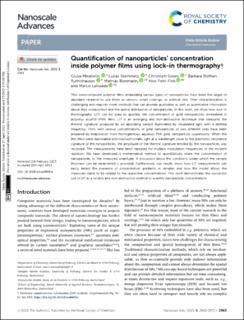Please use this identifier to cite or link to this item:
https://doi.org/10.21256/zhaw-27790Full metadata record
| DC Field | Value | Language |
|---|---|---|
| dc.contributor.author | Mirabello, Giulia | - |
| dc.contributor.author | Steinmetz, Lukas | - |
| dc.contributor.author | Geers, Christoph | - |
| dc.contributor.author | Rothen-Rutishauser, Barbara | - |
| dc.contributor.author | Bonmarin, Mathias | - |
| dc.contributor.author | Fink, Alke Susanne | - |
| dc.contributor.author | Lattuada, Marco | - |
| dc.date.accessioned | 2023-05-05T13:07:04Z | - |
| dc.date.available | 2023-05-05T13:07:04Z | - |
| dc.date.issued | 2023 | - |
| dc.identifier.issn | 2516-0230 | de_CH |
| dc.identifier.uri | https://digitalcollection.zhaw.ch/handle/11475/27790 | - |
| dc.description.abstract | Thin nanocomposite polymer films embedding various types of nanoparticles have been the target of abundant research to use them as sensors, smart coatings, or artificial skin. Their characterization is challenging and requires novel methods that can provide qualitative as well as quantitative information about their composition and the spatial distribution of nanoparticles. In this work, we show how Lock-In Thermography (LIT) can be used to quantify the concentration of gold nanoparticles embedded in polyvinyl alcohol (PVA) films. LIT is an emerging and non-destructive technique that measures the thermal signature produced by an absorbing sample illuminated by modulated light with defined frequency. Films with various concentrations of gold nanoparticles of two different sizes have been prepared by evaporation from homogenous aqueous PVAgold nanoparticles suspensions. When the thin films were illuminated with monochromatic light at a wavelength close to the plasmonic resonance signature of the nanoparticles, the amplitude of the thermal signature emitted by the nanoparticles was recorded. The measurements have been repeated for multiple modulation frequencies of the incident radiation. We have developed a mathematical method to quantitatively relate the concentration of nanoparticles to the measured amplitude. A discussion about the conditions under which the sample thickness can be determined is provided. Furthermore, our results show how LIT measurements can easily detect the presence of concentration gradients in samples, and how the model allows to relate the measured signal to the respective concentrations. This work demonstrates the successful use of LIT as a reliable and non-destructive method to quantify nanoparticles concentrations. | de_CH |
| dc.language.iso | en | de_CH |
| dc.publisher | Royal Society of Chemistry | de_CH |
| dc.relation.ispartof | Nanoscale Advances | de_CH |
| dc.rights | https://creativecommons.org/licenses/by/3.0/ | de_CH |
| dc.subject | Nanoparticle | de_CH |
| dc.subject | Polymer film | de_CH |
| dc.subject | Measurement | de_CH |
| dc.subject | Lock-In Thermography (LIT) | de_CH |
| dc.subject.ddc | 620: Ingenieurwesen | de_CH |
| dc.title | Quantification of nanoparticles’ concentration inside polymer films using Lock-In Thermography | de_CH |
| dc.type | Beitrag in wissenschaftlicher Zeitschrift | de_CH |
| dcterms.type | Text | de_CH |
| zhaw.departement | School of Engineering | de_CH |
| zhaw.organisationalunit | Institute of Computational Physics (ICP) | de_CH |
| dc.identifier.doi | 10.1039/D3NA00091E | de_CH |
| dc.identifier.doi | 10.21256/zhaw-27790 | - |
| zhaw.funding.eu | No | de_CH |
| zhaw.issue | 11 | de_CH |
| zhaw.originated.zhaw | Yes | de_CH |
| zhaw.pages.end | 2972 | de_CH |
| zhaw.pages.start | 2963 | de_CH |
| zhaw.publication.status | publishedVersion | de_CH |
| zhaw.volume | 5 | de_CH |
| zhaw.publication.review | Peer review (Publikation) | de_CH |
| zhaw.funding.snf | 184635 | de_CH |
| zhaw.webfeed | Sensors and Measuring Systems | de_CH |
| zhaw.author.additional | No | de_CH |
| zhaw.display.portrait | Yes | de_CH |
| Appears in collections: | Publikationen School of Engineering | |
Files in This Item:
| File | Description | Size | Format | |
|---|---|---|---|---|
| 2023_Mirabello-etal_Quantification-of-nanoparticles-concentration-polymer-films.pdf | 1.05 MB | Adobe PDF |  View/Open |
Show simple item record
Mirabello, G., Steinmetz, L., Geers, C., Rothen-Rutishauser, B., Bonmarin, M., Fink, A. S., & Lattuada, M. (2023). Quantification of nanoparticles’ concentration inside polymer films using Lock-In Thermography. Nanoscale Advances, 5(11), 2963–2972. https://doi.org/10.1039/D3NA00091E
Mirabello, G. et al. (2023) ‘Quantification of nanoparticles’ concentration inside polymer films using Lock-In Thermography’, Nanoscale Advances, 5(11), pp. 2963–2972. Available at: https://doi.org/10.1039/D3NA00091E.
G. Mirabello et al., “Quantification of nanoparticles’ concentration inside polymer films using Lock-In Thermography,” Nanoscale Advances, vol. 5, no. 11, pp. 2963–2972, 2023, doi: 10.1039/D3NA00091E.
MIRABELLO, Giulia, Lukas STEINMETZ, Christoph GEERS, Barbara ROTHEN-RUTISHAUSER, Mathias BONMARIN, Alke Susanne FINK und Marco LATTUADA, 2023. Quantification of nanoparticles’ concentration inside polymer films using Lock-In Thermography. Nanoscale Advances. 2023. Bd. 5, Nr. 11, S. 2963–2972. DOI 10.1039/D3NA00091E
Mirabello, Giulia, Lukas Steinmetz, Christoph Geers, Barbara Rothen-Rutishauser, Mathias Bonmarin, Alke Susanne Fink, and Marco Lattuada. 2023. “Quantification of Nanoparticles’ Concentration inside Polymer Films Using Lock-in Thermography.” Nanoscale Advances 5 (11): 2963–72. https://doi.org/10.1039/D3NA00091E.
Mirabello, Giulia, et al. “Quantification of Nanoparticles’ Concentration inside Polymer Films Using Lock-in Thermography.” Nanoscale Advances, vol. 5, no. 11, 2023, pp. 2963–72, https://doi.org/10.1039/D3NA00091E.
Items in DSpace are protected by copyright, with all rights reserved, unless otherwise indicated.